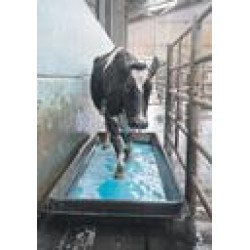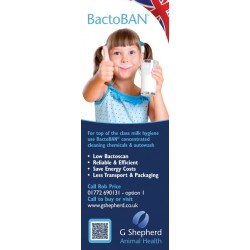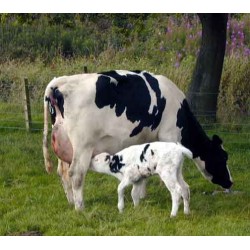Cutting carbon footprint begins with the calf
The link between carbon footprint and efficiency is well recognised and most dairy farmers are now keenly focussed on producing their herd’s milk in a more efficient way.
But what about their youngstock, and in particular, their calves?
If efficiency is not addressed in the two-year period before first calving, then the carbon footprint of milk production – which includes the rearing period – has the potential to massively increase.
Graham Shepherd is a Vet and owner of G Shepherd Animal Health – an independent company with a determined dedication to improving health and welfare.
He says the drive to improve efficiency and reduce the carbon footprint of milk production should begin from the moment the animal is born.
“This is not just because the two-year rearing period represents a substantial proportion of the animal’s life,” he explains. “But it is also because the youngest animals have a feed conversion ratio – turning feed into performance – which is better than at any other stage in their lives.”
Added to this is an increasing body of evidence which suggests the first 90 days of life can influence future milk production, with the udder now known to undergo rapid development – increasing in size over 60-fold – in this three-month period.
“We know that a well-developed cow has a greater capacity to convert feed into milk than one which has struggled with illness,” he says. “This is seen through calf scour, which has been shown to reduce fertility and milk production, and pneumonia, which reduces the chance of a heifer ever becoming a cow by 14%.”
But alongside this lost potential, the young calf is also at its most vulnerable, easily picking up infections which can have a devastating effect on efficiency and performance, and at worst, can result in death.
“Illness increases costs, reduces production and produces waste, all of which are bad for efficiency and carbon footprint,” says Dr Shepherd. “Furthermore, youngstock diseases often occur as outbreaks, affecting many animals at a time, and continuing on an ongoing basis.”
Staving off infection is therefore a priority, which he recommends is achieved through a two-pronged approach. This involves both:
- building up the animal’s resistance to disease, and
- reducing its exposure to infection.
Building immunity
Building a calf’s immunity so it’s equipped to fight infection begins with colostrum management.
“Calves are unlike other mammals in that they do not receive antibodies, which protect them from disease, through their mothers’ placenta,” he explains. “This means they must receive high quality colostrum, rich in antibodies, immediately after birth.”
He says the importance of speed in feeding colostrum is still not appreciated sufficiently widely.
“This cannot be over-emphasised, since the new-born calf’s ability to absorb antibodies through the gut wall, rapidly declines in its first 24 hours of life,” he says.
“If this process of passive transfer fails, it is not only likely to increase disease and mortality, but it can impact growth rates, milk production and reproductive performance later in the animal’s life,” he says.
For this reason, he says colostrum management must be stringent, so the newborn calf receives its first three or four-litre feed (or 10% of bodyweight), within at least two hours of birth.
Colostrum quality is equally essential and can be measured (such as with a refractometer), monitored and improved.
“A high level of hygiene should also be practised in colostrum management, and Pasteurisation may be needed. However, this depends on the farm, the pathogens known to be present, and whether colostrum is pooled,” he adds.
Reducing exposure to infection
Improving the calf’s resistance to disease, and its growth potential, also comes through environmental factors, many of which are intertwined with reducing its exposure to infection.
Maintaining hygienic practices in housing is key, and disinfection should be thorough and frequent, and should target any pathogens known to be present.
“It’s essential to know your enemy, whether managing colostrum, vaccinating calves or disinfecting buildings,” he says. “For example, Cryptosporidium is the most common cause of calf scour, yet many farm disinfectants are not even effective against this bug.”
Environmental factors such as draughts and wet bedding can also have a profound effect on performance.
“Being wet and cold is damaging at so many levels,” he warns. “It doesn’t just divert energy from the calf’s growth as it tries to keep warm, but it causes stress, so reducing its ability to fight infection.
“Wet and dirty bedding also provides the perfect opportunity for the growth of pathogenic bugs, so increasing the assault on an already weakened calf,” he adds. “And poor ventilation predisposes the calf to respiratory problems and potentially, lifelong under-performance.”
However, despite the pitfalls, Dr Shepherd says the good news is that every step taken – no matter how small – to improve the calf’s health and efficiency will have a knock-on positive effect on the carbon footprint of milk.




